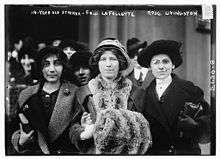Mink brigade
The mink brigade was a name used, at first mockingly, to refer to wealthy or otherwise socially privileged women who supported striking workers in the United States.

Unidentified striker, Fola La Follette and Rose Livingston
History
Anne Morgan, Alva Belmont and other wealthy strike supporters gained the attention of the press who labeled them the "mink brigade" during the New York shirtwaist strike of 1909.[1][2] The phrase was used again to refer to other women strike supporters, such as Fola La Follette in the 1913 New York Garment Workers Strike, to describe women whose dress and social status would give police pause in arresting them.[3]
Further reading
- Annelise Orleck (1995). Common Sense & a Little Fire: Women and Working-class Politics in the United States, 1900-1965. University of North Carolina Press. pp. 62, 93, 139. ISBN 9780807845110.
mink brigade.
- Susan Campbell Bartoletti (2003). Kids on Strike!. Houghton Mifflin Harcourt. pp. 146, 147. ISBN 9780618369232.
gollark: Yes, you don't need to specify anything I think.
gollark: I need a webhook created in here.]
gollark: Technically, it's 13:42, i.e. not midnight.
gollark: <@747764575587270718> only has webhook access to <#457999277311131649> though.
gollark: I don't have the authority.
References
- "Biography: Anne Morgan". PBS. Retrieved 2015-01-29.
- Laura B. Edge (2010). We Stand as One: The International Ladies Garment Workers Strike, New York, 1909. Twenty-First Century Books. pp. 74–85. ISBN 9780761363538.
- Carrie Brown (2002). Rosie's Mom: Forgotten Women Workers of the First World War. Northeastern. pp. 28, 37. ISBN 978-1-55553-535-3.
This article is issued from Wikipedia. The text is licensed under Creative Commons - Attribution - Sharealike. Additional terms may apply for the media files.